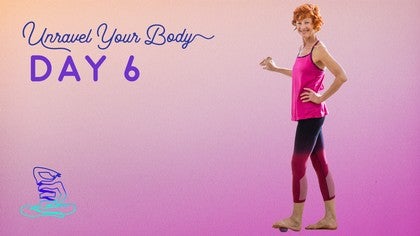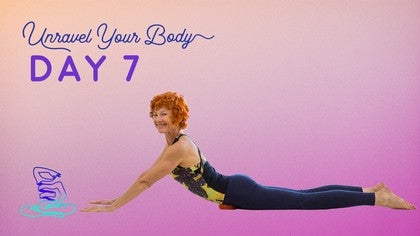Description
About This Video
Transcript
Read Full Transcript
Welcome today five. Today we're going to be doing release work on the knees and the calves, which are like grand central station of congestion and can have an amazing reaction when you start opening those areas up. Our pretest will be the traditional matte elephant walk we tidy ever gets done today. But I thought it would be an interesting place for you to test yourself. So in the real traditional way we were in Peloton stance. You roll down to the floor and walk your hands out.
And as far as you could go with your toes up. So the heels are down and the calves have to be pretty long. And then you walk your feet as close in as you could go, walked out again, walked in, and then the reversal would be [inaudible] back walking in and back and walking in. Now I know that many of you can't get to the floor. I happened to be spending a lifetime doing this so you can always test with some blocks.
So all you need is the height that your able to get to. So maybe this is your height and you can see, can I walk? Can I walk back? [inaudible] how far back can I go on my tea? Can I keep my toes up and my heels down as I do this? Just to check out the length of the calves. So you just play with it.
Just find something. Remember, again, this is just a testing to see how your body's going to change. And the other one is a squat. So in our math work, we always cross a feet and go to the floor. Traditionally, Joseph [inaudible] wanted us to sit down and stand up all the way. No hands and a test run for this would be a little bit more of a modification. Toes [inaudible] stand. Can you get your hips all the way down to the floor too, so you're actually resting on your knees.
This means mobility in the ankles, the shins, the knees, the calves, for sure. The hamstrings. If you can't get there, hold on to a Cadillac Wall and see where you get to. If you get this far that fine. That's our pretest. So this is a half foam roller, but you can really use anything. You can improvise and use a book and another book underneath. All you need is a slanting surface to start working your calf.
And I highly recommend being close to a wall so that you can really benefit the most. So when I place my foot down here, I have the ball of the foot up and I'm lining up my little toe and heel as much as possible and then seeing what needs to happen in my own body to keep my knee long and straight because there's a natural tendency to release there. And can I get my hip over my heel, my shoulder, over my hip, my head over my shoulders. So basically the whole back line of the body is being asked to open up. I definitely have a nice intense stretch on my calf and I can feel, it feels like I'm falling backwards. That's why I want the hand holding something because the body's too short.
It's used to being in a forward position. That's where it's organized its part and we want to take it to the next level of vertical alignment. So as you stand here, check is your weight going straight down into the heel, keep checking your alignment. And then if can you do this with an actually lift the weight off the other leg because then you're really stuck in your skeleton up. The other place check is the hips. Are they going straight forward? And I'm not wasting in and out. Once you have that, if you're ambitious and you have actually more that you can move with, how far forward can you bring the other leg without breaking somewhere?
Uh, because eventually this shouldn't be your legs swing when you're walking, when the hips are really open and the body is, is a tracking properly. So by now you're at probably, um, started noticing reliefs. So we shift over to the other side. I will stay on this side. So you can see, same thing, I'm checking my heel, a little toe to heel as a foot going straight forward. My hips, even on my, am I on my heel? Is My weight on the heel? Not The toes and then shoulders over hips, head over shoulders. So I just let, is my knee straight? Is your knee straight and then check and see.
I could feel that I was starting to hike up one hip. Do your hips feel even is the weight all on that foot? In this case I would recommend just testing this way it will take time to release this, but they do change and the whole back line of the body changes. So this affects more than just a cat than how far forward can you bring your leg. Can you stand like I can't fully stand at this leg and swing the leg forward, but now it's starting to open up a little bit.
That's really what you're aspiring to. So nice and long in the whole back side of the body. All right, so now you want to spend, we probably spend about two, two and a half minutes here. You can go up to two to four minutes on each side. It will change very fast.
The third one is like a wall roll down. So if I was leaning against the wall, let me move over here. Just like in a normal math class, the difference is that my feet are going straight forward. I'm not in a Pilati stance because I want to open up all these unusual angles that really allow the bones to hang straight without compromising and then from there starting to articulate my body down and rolling up again because the feet are elevated. There will be a much bigger intensity of stretch in the cabs and the whole back body and just maybe you won't even be able to get to the floor.
It really doesn't matter. What matters is that you keep rolling because you're asking for the elastic tissue in the backside of the body. The cavs, very specifically the ankles very specifically to start to release. You may even find a release happening in your spinal column in lower back because they're all connected up. So nice rolling motion going down and up. I have seen massive shift with how far people drop to the floor.
Just asking them to do this. You don't push, you just roll. Maybe you first time was here, second time was here, third time was here. You just let the tissue start to unravel. I'm going to go one more time.
I recovered from really bad injuries doing this and I highly recommend it as a procedure. Your calf is actually two pieces of muscle and in a perfect anatomy, they will be equally developed. So the outer calf and the inner calf, but with most people you will see one side much more developed than the other. So when you start out, you want have your foot more or less going straight back, you bring the jaw, the ball is close up into the back of the knee as you can. That bend of the knee should be very soft. You cuddling the ball in and then as you sit back try to control this calf.
At least in your imagination, you want to be sitting into the calf and actually spreading it so you have the right side in the left side of the cap ending. Now, if it's very extreme or very tight, you lighten a little bit inhaling and then you exhale to try and sink a little bit deeper into it because it's opening up all the tissue that become very hard and dry or you just stay there and take your time. There's no rush in this process. You want to work slowly. Your calf and your knee will change and release tension and the muscles. We'll go back into more optimal alignment and balance and get stronger. That's the beauty of this many people that their kneecap was slightly displaced.
Find this very helpful. Now you've sat here for a while, you take the ball and I'm just pushing the calf out. If you notice, I did not change my body at all and I'm dragging the tissue of the muscle out and then dragging the tissue of the muscle in so it's pulling the relationship of the calf to the joint. I can feel the tissue and its relationship to the whole kneecap joint being addressed and released. It's a wonderful thing to do. Back to the middle. Lighten up a little bit and roll the ball. Maybe halfway down your calf and then sit into the calf again. Maybe it'll go a little bit further down.
Try to check that your knee is in line with your hip so every other bones are tracking evenly and again, you may find that one side or one segment is much more painful than the other or tight. Just be aware of it and work those areas. We'll spend more time with them. It's your body and you can change anything you want. Again, I'm rolling out
So you can do two things for one back to the middle, rolling the ball further down. Now I'm at the bottom of my calf, settling into it again, checking my alignment. My knee is straight, my foot is straight, sinking into it, letting the body settle. I'm going a little bit deeper now and being aware, pressing the ball, trying not to lift up. That's really the trick. Staying sunk in. You want to be pressing the tissue back and forth against the bone. So it just having that fixed structure and becomes um, a, um, hydrated. Again, flexible again in its full potential is being restored and you may feel that there's little adjustments in your whole leg pattern as you do this because you're freeing up potential. Now moving to the other side, again, letting everything sit down.
By now my hip is cit sitting down into the heel and then moving back a little bit further and sitting right into the Achilles. So very good for the Achilles, allowing it to be adjusted, released it too can get very stick. Steph people say, oh, I have a really tight Achilles and the Achilles is attached into your heel and into your calves. So starting to lubricate all of that area is so, so therapeutic, rolling out a little bit. I can feel the relationship of the tendon to the foot rolling in a little bit. And then the final one, just bringing the foot up.
I'm actually hooking into the heel and lengthening it. So I'm tractioning my Achilles and sitting back and it's giving a lovely stretch and length into that joint, letting everything settle, trying to use my body weight to settle right down into this area. So Nice Long Achilles, long calf, soft knee, and then coming out of this side. So moving onto my other leg, my left leg, repeating the same thing. I'm coming forward and I actually catch the calf muscle and pull it down from the back of the knee joint. Um, and I try to soften the tissue in there.
We can get very grippy in the back of the knee and we want that part to be very, very soft. Make sure my alignment is straight and again sitting down trying to track the whole femur bone and shinbone and foot in a straight line and settle in. Imagining imagining the calf actually spreading evenly on both sides where re connecting. I just felt a release in my quad, the upper part as I was starting to release this down. Again, it takes a little time. You want to breeze. If it's very painful, you stay more forward with your body weight because it can be pretty harsh when you start. If you're more able to release your be more vertical, so more of your own weight becomes a lever into this whole process and again, I'm grabbing the ball and dragging the tissue out and holding it there. Sometimes people shift their bottom to do it or they lift up, do something and ship. You don't want that.
You want to be straight down full by whatever weight you're able to take and then nothing changes. You just drag the calf and the tissue. That's really where the therapeutic aspect of manipulating, it's like I'm grabbing the tissue of my forearm and manipulating it. That's what you're looking to do. And then grabbing the tissue and pulling the ball to the midline. So it's pulling in words, breathing if it hurts or lightening up the pressure a little bit.
Just allowing the body to figure out how do I let go of all this tension? How do I let go of this holding pattern? Because it's definitely a fixed pattern. Your body has kind of assumed is the best way to be. And it was until we're giving it a better way.
So from here, moving the ball halfway down your calf again, sitting straight down. Ah, my shinbone just let go of a lot of tension. Just letting the whole back of the calf release. I highly recommend, by the way, I am holding onto this ball threw out. If I didn't, it would fly off in some direction cause I can feel the tissue wanting to push along a different flow line and I don't want that to happen. I want the spasm to let go. So controlling the ball, very useful, pressing out.
So dragging the tissue out without the line of the bone changing, dragging the ball in. You may feel a lot of connectivity in with the kneecap. The Quad, the inner thigh, outer side, just depends what your pattern is, but it's all good. Back to the middle of taking the ball down to the lower calf, settling in, letting the tissue soften, relaxing as much as you can, but making sure your alignment is straight or your bone stacked. Is your leg even rolling it out so it's all, yes, it just moved a whole segment more. Again, the muscles can create adhesions that lock into the bone and then the bone and the muscle is a little bit more restricted. Rolling inwards and now coming up, I'm checking that my foot is straight back.
There's nice pressure into Achilles' sitting back into this, letting the Kelly's be slightly massage with pressure into it to soften it up. Rolling out a bit.
Sitting back and I can actually feel some traction into the Achilles. It's very pleasant for me. Lengthening this whole area up and then coming out of the whole thing. So now we get to retest and see what has changed in our legs, in our cabs, in our knees. How do they feel now? So again, standing in a Palati stand, actually no standing with my feet parallel and my toes up, lengthening into the backs of the knees, going down to the floor and walking out. Remember again, you can always use blocks.
How far out I can definitely go a whole lot further cause I can feel my calves opening and then walking in and one more time a walkout and walking in. How far in can I go? Quite a bit. Going backwards, all that's a challenge. But my definitely more lengths in the backs of the calves coming in. And one more time walking out.
So with your feet in a Pilati stance, nice lift if possible. The shoulders over the hips all the way down, all the way up. One note is that the knees can come further forward than the toes. I know a traditionally we're told never to do that, but we want full flection in the ankle and the Achilles. And can we go? How far down can you get? Because the knees and the calves have to release.
This is where babies hang out to relax and that's an ability that's very, very primal and the human body. Hope you were closer to your primal self. Thank you very much.
Unravel Your Body Challenge: with Niedra Gabriel
Comments
Foot and leg alignment Deborah lessen 997
Meredith Rogers jumpboard classes
Sarah Bertucelli 3345, 2567
Ruth Alpert 3117
Miriam Kane...all of her classes, but especially 3322
Marika Molner 2811
Amy Havens 822, 2413, 2519 and any of her jumpboard classes which helped me to restrengthen my feet in a non weight bearing way
Rebecca Rotstein 2936, 1816
Phillip Beach 2217
Tom McCook 2826
Troy McCarty 1954
Cathleen Murakami 1225
All of Victor Uygan’s classes because he is dancer focused and is very helpful to me with alignment and exercises for the feet.
Juan Nieto, his classes are runner focused and also concerned with alignment
Erika Quest bosu classes, great for strengthening ankles I do some bosu/balance work every day and have seen immense progress
Niedra Gabriel 856, 1349, 2308, 923
Also when I started rolling my feet, I had to begin in a seated position so my full weight wasn’t on the balls. Now I am able to do it standing. These have all been helpful to me. I hope they help you as well. I just started searching for foot focused classes and that’s how I found all of these.
You need to be a subscriber to post a comment.
Please Log In or Create an Account to start your free trial.





















